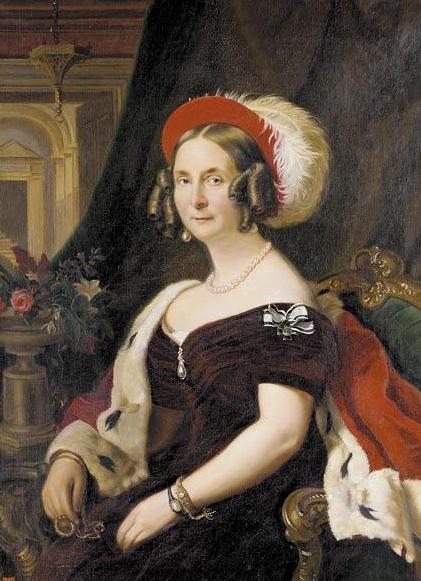by Scott Mehl © Unofficial Royalty 2018

Antoinette of Saxe-Altenburg, Duchess of Anhalt; source: Wikipedia
Princess Antoinette of Saxe-Altenburg was the wife of Friedrich I, Duke of Anhalt. She was born Princess Antoinette Charlotte Marie Josephine Karoline Frida on April 17, 1838, in Bamberg, Kingdom of Bavaria, now in Bavaria, Germany, to Prince Eduard of Saxe-Altenburg and his first wife, Princess Amalie of Hohenzollern-Sigmaringen. Antoinette had three full siblings:
- Princess Therese (1836-1914) – married Prince August of Sweden, no issue
- Prince Ludwig (1839-1844) – died in childhood
- Prince Johann (1841-1844) – died in childhood
Antoinette also had two half-siblings from her father’s second marriage to Princess Luise Caroline Reuss of Greiz:
- Prince Albert (1843-1902) – married (1) Princess Marie of Prussia, had issue; (2) Duchess Helene of Mecklenburg-Strelitz, no issue
- Princess Marie Gasparine (1845-1930) – married Karl Günther, Prince of Schwarzburg-Sondershausen, no issue

Friedrich I, Duke of Anhalt. source: Wikipedia
In Altenburg on April 22, 1854, Antoinette married the future Friedrich I, Duke of Anhalt. He was the son of Leopold IV Friedrich, Duke of Anhalt and Princess Friederike of Prussia. The couple had six children:
- Leopold, Hereditary Prince of Anhalt (1855-1886) – married Princess Elisabeth of Hesse-Kassel, had issue
- Friedrich II, Duke of Anhalt (1856-1918) – married Princess Marie of Baden, no issue
- Princess Elisabeth (1857-1933) – married Adolf Friedrich V, Grand Duke of Mecklenburg-Strelitz, had issue
- Eduard, Duke of Anhalt (1861-1918) – married Princess Luise of Saxe-Altenburg, had issue
- Prince Aribert of Anhalt (1866-1891) – married Princess Marie Louise of Schleswig-Holstein, no issue, marriage dissolved
- Princess Alexandra (1868-1958) – married Sizzo, Prince of Schwarzburg, had issue

Antoinette, Duchess of Anhalt. source: Wikipedia
At the age of 70, four years after the death of her husband, Antoinette, The Dowager Duchess of Anhalt died in Berchtesgaden, Kingdom of Bavaria, now in the German state of Bavaria, on October 13, 1908, and was buried in the Ducal Mausoleum (link in German) in Dessau, Duchy of Anhalt, now in the German state of Saxony-Anhalt. In 1958, the remains of members of the House of Anhalt were removed from the Ducal Mausoleum secretly by night for political reasons (Dessau was then in Communist East Germany) and reburied in the Ziebigker Cemetery in Dessau in a common grave, marked only by a simple wooden cross. In 2019, Antoinette’s remains were moved a second time and reinterred in the Marienkirche (link in German) in Dessau, the traditional burial site of the Dukes of Anhalt-Dessau dating back to the 15th century. The Marienkirche was destroyed during World War II and has since been rebuilt.
This article is the intellectual property of Unofficial Royalty and is NOT TO BE COPIED, EDITED, OR POSTED IN ANY FORM ON ANOTHER WEBSITE under any circumstances. It is permissible to use a link that directs to Unofficial Royalty.
Anhalt Resources at Unofficial Royalty

























